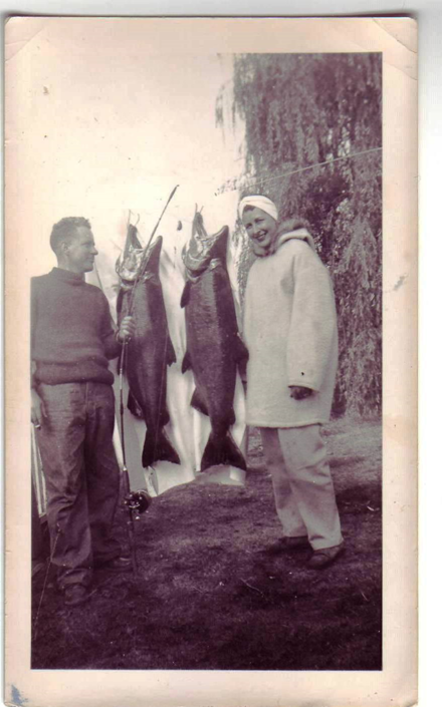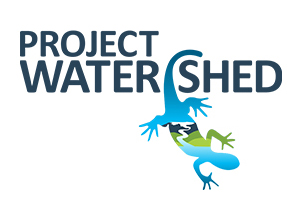[av_textblock size=” font_color=” color=” admin_preview_bg=”]

1940’s Betty and Hibbert McLeod with a 69 and a 72 pound Tyee
As the New Year starts we often reminisce about years past with our children, grandchildren, and great grandchildren.
Being a coastal community, often the conversations lead to activities that occurred on the beautiful K’ómoks Estuary. One of the many memorable activities enjoyed on the water was sports fishing.
What was it like in the last century? The Comox Valley was the hottest sports fishing spot on Vancouver Island! For us relatively new comers, older residents will talk about ‘Tyees’, a Tyee is a salmon that weighs in excess of 30 pounds. As Tyee fishing was once prosperous in the Comox Valley, Tyee clubs existed that had hundreds of members, this fishing still occurs in Campbell River.
In the 1920’s, we have records showing reports from August 1925 suggesting that over 100 Tyees were caught in a 2 day period with the largest being 60 pounds. In August 1929, Cecil Smith landed a 61 pound Tyee. Reports in the 1930’s are also impressive. During the summer of 1932 15 boats caught a total of 2,265 pounds of Tyee salmon (all fish were over 30 pounds). Fishing for Springs or Chinook salmon remained good right through the 1950’s and a portion of the 1960’s. (Land of Plenty, A History of the Comox District, D.E. Isenor et al, Ptarmigan Press)
During the last part of the 20th century a number of misguided moves were made politically which had a dramatic and profound effect on the estuary. Our history shows that these moves were made despite the outcries from city, town and Regional District planners, as well as environmental leaders. Such as Ruth Masters who along with her two contemporaries Melda Buchanan and Norma Morton were key figures in the conservation and environmental movement during the middle part of the last century.
In most cases, the industry that affected the estuary has gone or is disappearing and restoration and protection efforts can help secure a comeback of this critical estuarine habitat. It was this thinking that led Project Watershed to establish the Kus-Kus-sum sawmill restoration project.
It is only the longtime residents of the valley who remember the way it was. Norma Morton, historian for the Project Watershed’s Estuary Working Group relayed this charming fish story to me about the “one that got away” (Dec 2009).
[/av_textblock]
[av_testimonials style=’grid’ columns=’2′ grid_style=” interval=’5′ font_color=” custom_title=” custom_content=” admin_preview_bg=”]
[av_testimonial_single src=’9928′ name=’Norma Morton’ subtitle=” link=’http://’ linktext=”]
“It was 3:30 a.m. on a Sunday morning in August 1944 and still pitch dark. My Dad quietly opened our bedroom door and said “breakfast is ready and it’s time for you two girls to go out and learn to catch a Tyee by yourselves”.
Sheila, my sister, was fourteen and I was thirteen, and had spent many summer days on the waters around Comox, and knew about the famous “Tyee pool”, where the big fish gathered near the black dolphin with the white triangle at the top (near Goose Spit) – which marked the entrance to the Courtenay River.
Carrying tackle and oars we walked with my father from our house, down to the wharf and the King Salmon Tyee Club. Overhead the sky was ablaze with stars and the water glassy calm. There was no electricity provided on the float, but we could see small flashlight beams, and hear muffled voices as others ahead of us were preparing to catch Tyee.
Soft splashes told us row boats were being launched. The rule at that time was “no motors allowed” when going fishing for Tyee. We were to use our light ten foot skiff, with a broad beam. My sister and I could sit side-by-side and each take an oar to speed the journey to the pool. We could hear the splash of other oars, and see shadows which marked other boats, everyone keeping a careful distance from each other. The dawn started to break and we could see the magic of all the boats scattered here and there at the pool, as the sky became pink and gold just before sunrise.
Sheila moved to the stern, lifted the rod and tackle and pulled on the line to measure out the lengths as the line went aft, so the weights and spoon could drop into the depths. She was the fisher person, I liked to row.
All of a sudden she gave a jerk on the line and said: “I’ve got one!” I lifted the oars and she let the fish run. Our skiff was very light and we were pretty skinny girls so the fish started to give us a ride. It was a courtesy in those days, when someone had a fish on, to pull away, and the order was “give them room!”. This also prevented others’ tackle from getting fouled, and some would pull in their lines.
The Tyee came back toward us, my sister keeping the line taut and I could see a small bow wave at its dorsal fin, which looked like a shark’s fin as it cut the water. It took us off in another direction. I did not put the oars in to brake the skiff, but the fish gave a sudden extra pull and the line went slack. “It’s gone”, Sheila said with some exasperation as she reeled in the line. There was nothing on the end, it had broken the line and my Dad’s tackle was out there in the depths with the Tyee. I don’t remember how long it towed us around, maybe only fifteen minutes, but it was quite a thrill!
One of the “regulars” at fishing Tyee, (we all knew him as ‘Jake’ as he had caught many Tyee), rowed over to us, and said; “you two little girls were lucky that big fish got off, you would never have been able to lift it into the boat!”
Our biggest concern and disappointment was to have to go home and tell my Dad we had hooked a Tyee but it got off, and we lost his tackle. He just grinned and said: “that’s just great – I didn’t give you any of my best spoons”.
[/av_testimonial_single]
[/av_testimonials]
[av_textblock size=” font_color=” color=” admin_preview_bg=”]
I am sure many of our older Comox Valley residents have wonderful stories like Norma’s. And just to indicate that at the time of Norma’s story, Tyee’s were still being caught, her cousins Doug and Barb McLeod provided the family photo of Doug’s mother Betty, who in the late 1940’s pulled in a 69 and a 72 pound Tyee. She is shown in the photograph with her husband Hibbert and her two Tyees.
Will it ever be like this again? Probably not, but if we continue to protect and restore the K’omoks Estuary such as successfully completing the Kus-kus-sum project, and make sound decisions as we move forward, we can only hope for a return of abundance.
Written by Paul Horgen
Comox Valley Project Watershed Chair
[/av_textblock]
[av_one_third first min_height=” vertical_alignment=” space=” custom_margin=” margin=’0px’ padding=’0px’ border=” border_color=” radius=’0px’ background_color=” src=” background_position=’top left’ background_repeat=’no-repeat’ animation=” mobile_display=”]
[av_image src=’https://projectwatershed.ca/wp-content/uploads/2018/01/Dam-Fishing-300×178.jpg’ attachment=’9937′ attachment_size=’medium’ align=’center’ styling=” hover=” link=” target=” caption=” font_size=” appearance=” overlay_opacity=’0.4′ overlay_color=’#000000′ overlay_text_color=’#ffffff’ animation=’no-animation’ admin_preview_bg=”][/av_image]
[/av_one_third][av_two_third min_height=” vertical_alignment=” space=” custom_margin=” margin=’0px’ padding=’0px’ border=” border_color=” radius=’0px’ background_color=” src=” background_position=’top left’ background_repeat=’no-repeat’ animation=” mobile_display=”]
[av_promobox button=’yes’ label=’Email Your Story’ link=’manually,mailto:info@kuskussum.ca’ link_target=” color=’theme-color’ custom_bg=’#444444′ custom_font=’#ffffff’ size=’large’ icon_select=’no’ icon=’ue800′ font=’entypo-fontello’ box_color=” box_custom_font=’#ffffff’ box_custom_bg=’#444444′ box_custom_border=’#333333′ admin_preview_bg=”]
If you have a story you would like to share about the K’ómoks Estuary (also know as Courtenay Estuary or Comox Harbour) email us, we would love to hear it!
[/av_promobox]
[/av_two_third]

